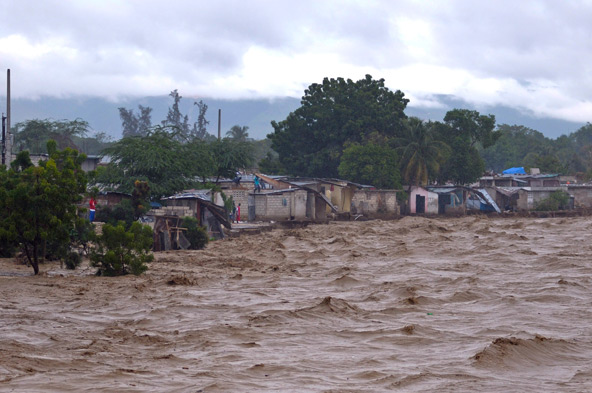
SANTO DOMINGO, Dominican Republic (CNS) — As the effects of Hurricane Sandy lingered in the Caribbean, church workers were trying to gauge the extent of the damage left in its wake.
The storm moved north of Cuba and into the Bahamas as a Category 1 hurricane the morning of Oct. 26, but downpours and high winds persisted in Cuba and on the island of Hispaniola, shared by the Dominican Republic and Haiti.
Government officials said 16 people were killed in Haiti, 11 people had died in eastern Cuba, and Jamaica and the Bahamas reported one death each from the storm.
The storm whipped winds that tore off roofs and downed power lines and brought heavy rain that flooded rural communities and city streets alike.
Church workers in those countries were struggling to assess the extent of the damage.
“It’s difficult to say how much damage there was, but it has been very bad in the eastern part of the country,” said Rosario Lo, a representative of Caritas in Havana, the Cuban capital.
Lo said tens of thousands of homes and people were affected but declined to give a firm number. She said Caritas was ready to respond with emergency provisions.
Cuban officials said it was the worst storm to hit the island since 2005 when Hurricane Dennis caused more than $2 billion in damage.
In Holguin, a province of slightly more than 1 million people in northeast Cuba, church workers said the effects of the storm were still being felt but the damage was already visible.
“It ripped off roofs of houses. There’s a lot of material damage, much more in the countryside than in the city” of Holguin, the provincial capital, said a church worker at the Holguin Diocese.
“It’s still raining and the winds are still strong, but the worst has passed,” he said in a telephone interview. The phone lines went dead as he spoke.
Holguin and the province of Guantanamo, also in eastern Cuba, were worst hit, Lo said.
Photos from Santiago de Cuba, the second-largest city on the island, showed downed trees, flooding and destroyed homes. Phone calls to the Catholic archdiocese there went unanswered.
Haitian officials said thousands of homes were flooded, destroyed or damaged and more than 10,000 people were living in temporary shelters.
Officials evacuated more than 1,000 of the some 370,000 people still living in camps since the January 2010 earthquake.
Widespread flooding was reported, but the worst damage appeared to be concentrated in the country’s southern peninsula.
There, Caritas and Catholic Relief Services began distributing hygiene and cooking kits to 1,250 families and had readied emergency food supplies to distribute to victims.
— By Ezra Fieser, Catholic News Service






